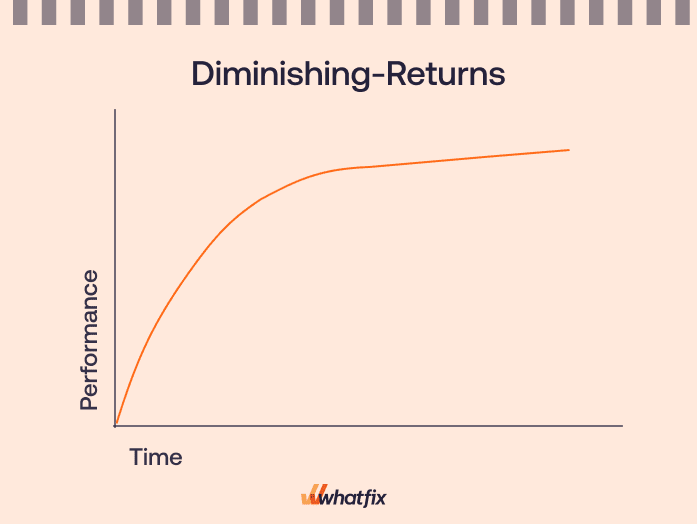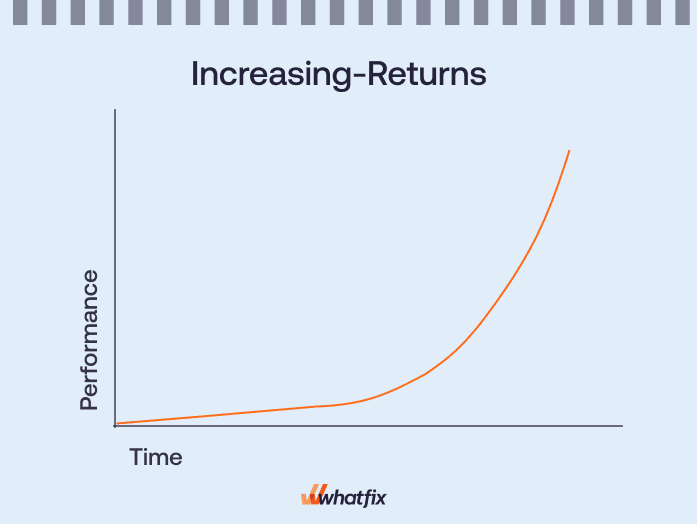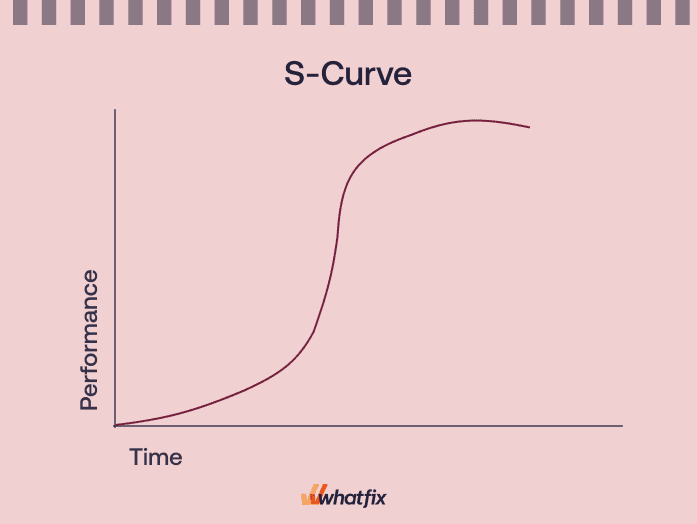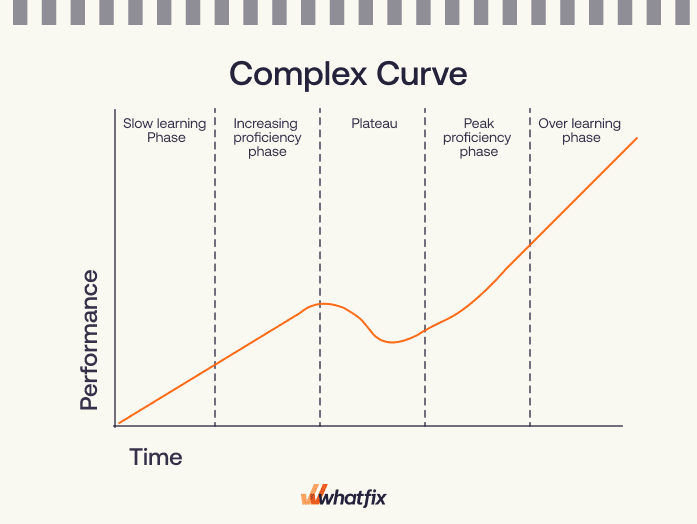
In the diminishing-returns learning curve, the rate of progression increases rapidly at the start of learning and decreases over time. This can describe tasks that are easy to learn and rapidly progressing skills. Activities that follow a diminishing returns learning curve are more straightforward when measuring and predicting how the workforce’s performance and output will change over time.

Once a learner obtains full proficiency in a task, the progression levels off (called a plateau), and the learner no longer improves his time-to-completion rates. This is either due to maximizing task efficiency or fatigue having set in.
In the increasing-returns curve, the rate of progression is slow at the start and rises over time until full proficiency is achieved. This describes tasks that are difficult to pick up and have slow skill acquisition rates.

No action items are required here in terms of decision-making, as the initial cost of slow learning is quickly returned upon reaching the high-efficiency phase. However, if the rest of the data shows that the task should not take very long for employees to learn, this graph indicates that you should modify your employee training methods .
The “S” curve model, also known as the increasing-decreasing return learning curve model, is the most commonly cited type of learning curve model. It represents learners entirely new to a task.

The bottom of the curve represents how learners are slow to perform a new task initially and have slow improvement progression. However, as learners complete a task over time, they take less and less time to complete it and experience a rapid improvement in proficiency until the skill is acquired, at which point performance (and the learning curve) flatten. This represents an overall plateau that has been reached in terms of maximum task efficiency or a new challenge has emerged acting as a barrier to improvement.
The complex learning curve is designed to model and map more complicated learning patterns on the way to task mastery and requires more detailed progression tracking. This suggests that the measured task is challenging to learn and takes a certain amount of practice before a learner can become proficient.

The complex learning curve model looks different for each activity, individual, or group. When learning tasks with complex learning curves, learners often encounter multiple peaks and plateaus.
The learning curve model helps monitor various aspects of company performance and identify areas that need improvement. It provides insights into employee training and performance, but limitations do exist with the learning curve model.
Let‘s examine some key advantages and disadvantages of the learning curve model.
L&D teams can use the learning curve model to determine the time needed for a person (or group of people) to master a new skill or process. In many workplace applications of the learning curve model, the actual learning is the process improvement.
With project management, teams become more proficient by processizing repeated tasks or similar projects. Initially, a project may take longer and involve more resources due to unfamiliarity or unanticipated challenges. However, as the team gains experience, they develop more efficient processes, problem-solving skills, and a deeper understanding of the project requirements. This leads to reduced time and cost in subsequent projects.
The learning curve can track its workforce’s performance with its manufacturing costs by replacing “performance” and “number of attempts” with total production in units or cost per unit. As time progresses, workers will produce more and the “per-unit” cost will decrease.
Organizations can predict this reduction in per-unit cost by modeling the change with the learning curve. This is done by considering labor costs and employee training and will impact the cost of a good or service. Initially, the product may reach the market at a higher price point because of the high per-unit cost to produce a good. Over time, this will decrease as the workforce’s efficiency increases.
When onboarding and training new employees , L&D teams are tasked with accelerating the time-to-productivity for new hires. With the learning curve model, organizations can measure the amount of time different tasks and processes take to master, allowing business operations teams to forecast company growth better and enable employees to succeed in new roles.
Introducing new technology in an organization typically involves multiple learning curves. Let’s look at technology adoption from an enterprise perspective, specifically implementing a new technology like a CRM or ERP.
Initially, employees may struggle using the new systems and incorrectly use the software’s workflows, reducing productivity and potentially leading to internal resistance to change . With enterprise software being highly complex and custom-built for business requirements, employees start from square one. Their only experience may be with similar tools and tasks, but not with the ones they’re now learning. It presents a significant barrier to change management that involves overcoming a complex learning curve.
Over time, as they become more familiar with the technology, their proficiency improves, leading to increased productivity, innovation, and often a competitive advantage. This occurs when organizations achieve digital adoption , where employees (or application end-users) efficiently complete tasks, enabling organizations to achieve the intended business outcomes of a technology implementation and maximize their digital transformation ROI .
CASE STUDY How REG reduced time-to-proficiency of its CRM and ERP by 50%REG’s L&D and IT team faced challenges training employees to its highly customized Salesforce CRM and JD Edwards ERP instances. New employees took upwards of six months to become proficient with the system, leading to frequent account errors and incorrect process usage. Existing users were failing to adapt to new processes and adopt new features.
Whatfix enabled REG to standardize its end-user training via contextual in-app guidance in the flow of work. With Whatfix, REG reduced its time-to-proficiency for its CRM and ERP by 50%, equally a 3-month faster onboarding time for new employees. It also reduced daily IT support tickets by 600% by deflecting issues with in-app support.
“Whatfix reimagines our training. It supports in-app guidance across almost any interface and platform. And it’s so easy to update materials, we can at last keep pace with the system changes. Looking back, Whatfix was one of the best decisions we have made.”